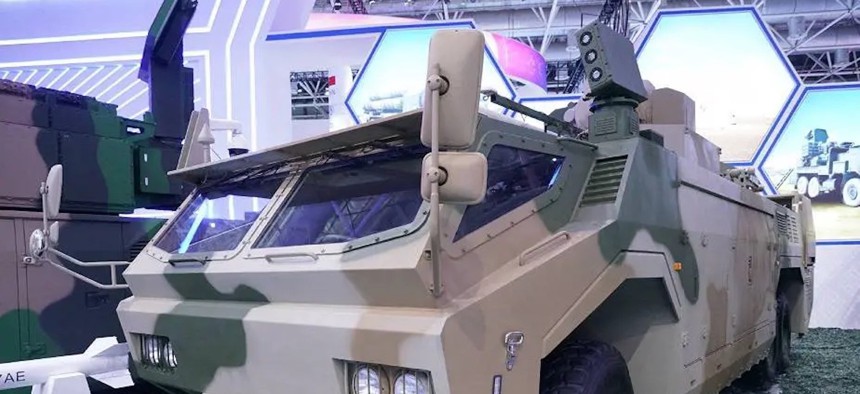
The LW-30 laser defense system, a vehicle-mounted “drone killer” developed by China Space Sanjiang Group and unveiled In November at the Zhuhai Airshow in China. CASIC
China Gears Up To Shoot Down US Drones
Its military-industrial complex is already working on a list of technologies needed to fight off swarms of UAS.
Drones continue to move toward the center of U.S. warfare, emerging as a major spending priority and a go-to solution for almost every defense challenge—most especially in a conflict with China.
Networked drone swarms proved decisive in a recent Air Force simulation of a Taiwan Strait conflict: they broke through China’s anti-access/area denial efforts and ensured U.S. victory, according to RAND’s David Ochmanek, a former deputy assistant defense secretary for strategy. In turn, Hudson Institute’s Bryan Clark, a former special assistant to the chief of naval operations, has identified drones as the only means to fill in for an expected gap in American missile production. It is not surprising, then, that China has begun to develop countermeasures.
A highlight of November’s Zhuhai Airshow was the LW-30 laser defense system, a vehicle-mounted “drone killer” developed by China Space Sanjiang Group. An “optimized” version of a weapon that debuted at the 2018 show, the LW-30 closely resembles the “Silent Hunter” system produced by China’s Poly Technologies and deployed by Saudi Arabia in September.
China Sanjiang and state media claim that the LW-30 can down small drones several kilometers away, taking just a few seconds to swivel, fire, and move on to the next target. Using electricity to down a drone is far cheaper than physical munitions; China Sanjiang estimates it costs about a dozen Chinese yuan (roughly $1.75) per kill.
If the claims are true, the Chinese company has conquered an enduring engineering challenge: maintaining laser fire on a small moving target long enough to damage it. And a spokesman said the company is working to upgrade the LW-30’s 30-kilowatt beam to higher energy, reducing the time needed to destroy its targets.
China’s development of the LW-30 and other anti-drone weapons builds upon an increased interest in drone and counter-drone warfare in PLA military writings. The 2020 Science of Military Strategy, a theoretical military teaching text published by the PLA’s Academy of Military Sciences, noted that “intelligent unmanned systems have become an indispensable force on the [21st-century] battlefield,” with countries such as the U.S., Israel, and Russia using them to great effect. More recently, Chinese media have written about the critical role of UASs in the 2020 Armenia-Azerbaijan war and today’s Russia-Ukraine war. In both conflicts, defenders have struggled to stop drones used as a relatively cheap yet highly effective alternative to manned aircraft for intelligence, surveillance, and reconnaissance (ISR) and combat missions.
A June article in PLA Daily admitted that advancements in UAS technology have severely strained traditional air defenses; “low, slow, and small” UASs in particular are very difficult to detect with radar, track with guided munitions, and strike with aerial or anti-air guns. What’s needed, the article said, are three-dimensional, multi-domain networks of detection equipment and counter-drone weapons to maximize the range and speed of early-warning and interception—specifically, networked anti-air guns; electronic interference to disrupt navigation and communications; directed-energy beams (i.e., laser weapons like the LW-30); high-power microwave weapons; and autonomous counter-drone systems such as drone swarms.
China’s military-industrial complex is already working on the list. Most efforts are led by the China Aerospace Science and Industry Corporation (CASIC), the giant state-owned aerospace corporation that is the parent company of China Space Sanjiang Group. Many other entities have also played prominent roles, including Poly Technologies, China Electronics Technology Corporation (CETC), and China Academy of Engineering Physics (CAEP).
Besides the LW-30 laser, the 2022 Zhuhai Airshow also featured an anti-drone system produced by CASIC’s Second Academy, which exemplifies the “three-dimensional network” design philosophy. The system is built around the HQ-17AE short-range air-defense system, which can guide four missiles to intercept up to four airborne targets simultaneously at a slant range of 1.5 to 20 kilometers. The Second Academy claims it is effective against UASs, fixed-wing and rotary-wing aircraft, cruise missiles, and tactical air-to-ground missiles. The network also incorporates the man-portable QW-12 anti-air missile system and the unmanned ZR-1500 smart defense system, which can be equipped with micro-missiles, small missiles, loitering munitions, and machine guns. Its sensors include an electro-optic radar and a DK-1 low-altitude detection radar working in tandem. The 3D system’s brain is the ZK-K20 ground missile anti-air control system, which processes the detection data and quickly deploys the appropriate weapons. The system is also armed with “soft” anti-drone measures such as electronic interference and deception.
In short, the arms race for UAS and counter-UAS technologies is in full swing. As drones both thwart traditional defenses in conflicts like Ukraine and feature more and more in U.S. defense plans, the multifaceted countermeasures displayed at the Zhuhai Airshow demonstrate that Beijing too is making its own preparations for this key part of the future of war.
Daniel Shats is a research analyst with BluePath Labs, a D.C. defense and tech-focused consulting firm.
P.W. Singer is Strategist at New America and the author of multiple books on technology and security.



